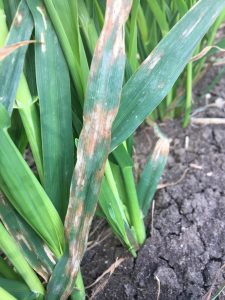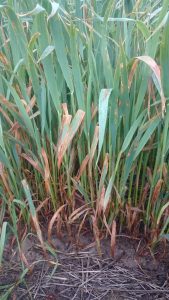Red leather leaf (RLL) is favoured by cool and wet seasonal conditions and was found in at least 80 per cent of oat crops in the medium and high rainfall zones of Victoria during 2019 and 2020. This makes it the most prominent foliar disease of oats in south-eastern Australia. Red leather leaf was uncommon in low rainfall zones and generally at levels unlikely to cause losses.
What to look for
Initial infection appears as small, pale blue coloured lesions with a red/red-brown edge, typically during the tillering stages. During the stem elongation to head emergence stages, symptoms appear as red, irregular shaped lesions, which spread across leaves. Later in the season, affected leaves take on a ‘leathery’ appearance which turn a red, brown colour and may be slightly rolled.

Characteristic symptoms of Red leather leaf (RLL) in oats; pale blue lesions with a red/red-brown edge at early stages (Photos: Mark McLean — Agriculture Victoria)

Characteristic symptoms of Red leather leaf (RLL) in oats; leathery appearance later in the season (Photos: Mark McLean — Agriculture Victoria)
Disease Cycle
Red leather leaf (RLL) is caused by the fungus Neospermospora avenae. It is a stubble and seed borne disease, but its survival and mode of infection is not well understood. Primary infection is most likely from mycelium on seed and spores from stubble during cool (5–16°C) wet weather. Symptoms are first observed during tillering and stem elongation stages. Secondary infection of the upper canopy comes from wind and splash dispersed spores during wet weather.
Economic Importance
Red leather leaf has been found to cause 5–20 per cent (0.3–1.1 t/ha) grain yield loss in susceptible milling varieties and significant reductions to grain plumpness (screenings) and weight in the medium and high rainfall zones. In hay crops, Red leather leaf has been found to significantly reduce plant biomass, height and stem thickness. Losses of 10-22 per cent (0.8-3.2 t/ha) were common in Susceptible (S) and Susceptible to Very Susceptible (SVS) rated varieties. Less frequent and severe losses were recorded for Moderately Susceptible (MS) or better rated varieties. Losses are most likely during seasons with wet conditions during winter and early spring as this favours disease development.
Management
Cultural Practices
Infected seed and stubble are the sources of primary infection for Red leather leaf. Avoid sowing oats into oat stubble from the previous two seasons by allowing 2–3 years before resowing oats into the same paddock to allow the inoculum to breakdown.
Resistant Varieties
Growing Moderately Susceptible (MS) or better rated varieties will significantly reduce risk of loss. Susceptible (S) or Susceptible to Very Susceptible (SVS) rated varieties frequently have grain/hay yield and quality loss during seasons favourable for Red leather leaf. See a current Cereal Disease Guide or the NVT website for up to date ratings.
Fungicides
Foliar fungicides have been found to provide suppression of Red leather leaf, but may not provide full control. Timing of foliar fungicide application is very important with experiments conducted in the high and medium rainfall zones having shown that the best timing was mid-tillering (Z25) to stem elongation (Z31). This is because application coincides with early disease development.
It is important to follow labels rate for oats and rotate fungicides with different modes of action to minimize the opportunity for fungicide resistance developing. See the Fungicides chapter for further information about fungicide resistance.


